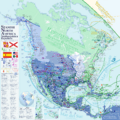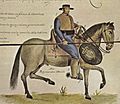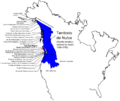Viceroyalty of New Spain facts for kids
Quick facts for kids
Viceroyalty of New Spain
Virreynato de Nueva España
|
|||||||||||||||||
|---|---|---|---|---|---|---|---|---|---|---|---|---|---|---|---|---|---|
1521–1821 |
|||||||||||||||||

map of New Spain in red, with territories claimed but not controlled in orange.
|
|||||||||||||||||
| Capital | Mexico City | ||||||||||||||||
| Common languages | Spanish | ||||||||||||||||
| Religion | Roman Catholicism | ||||||||||||||||
| Government | Monarchy | ||||||||||||||||
| King of Spain | |||||||||||||||||
|
• 1535-1556
|
Charles I | ||||||||||||||||
|
• 1813-1821
|
Ferdinand VII | ||||||||||||||||
| Viceroy | |||||||||||||||||
|
• 1535-1550
|
Antonio de Mendoza | ||||||||||||||||
|
• 1821-1821
|
Juan O'Donojú | ||||||||||||||||
| History | |||||||||||||||||
| August 16 1521 |
|||||||||||||||||
|
• First viceking appointed
|
1521 | ||||||||||||||||
| 1810 | |||||||||||||||||
| September 28 1821 | |||||||||||||||||
| Population | |||||||||||||||||
|
• 1519
|
20.000.000 | ||||||||||||||||
|
• 1810
|
7.657.300 | ||||||||||||||||
| Currency | Peso de Oro | ||||||||||||||||
|
|||||||||||||||||
The Viceroyalty of New Spain was a huge territory ruled by Spain from 1521 to 1821. It was part of the Spanish Empire and included lands in North America and some islands in Asia.
The Spanish called the area that is now central and southern Mexico "New Spain." Since the main city of this territory was Mexico City, the name "New Spain" also referred to the entire large area governed from there.
Contents
Where Was New Spain?
The Viceroyalty of New Spain covered a vast area. It included:
- Most of modern-day Mexico.
- Many islands in the Caribbean like Cuba, Puerto Rico, and Hispaniola (which includes modern-day Haiti and the Dominican Republic).
- Parts of Central America, reaching down to the southern border of Costa Rica.
- A large part of the southwestern United States. This included all or parts of states like California, Nevada, Utah, Colorado, Wyoming, Arizona, New Mexico, Texas, and Florida.
- Islands in the Pacific Ocean, such as the Philippines and the Mariana Islands.
Spain also claimed lands further north, like parts of British Columbia and Alaska. However, the northern border was set by the Adams–Onís Treaty in 1819. Before 1717, Venezuela was also part of New Spain, but it later joined another Spanish territory called the Viceroyalty of New Granada.
How New Spain Was Ruled
The vast lands of New Spain were divided into smaller areas called provinces. Each province had a governor who was in charge of managing the area. The governor also often led the local army and defense groups.
These provinces were grouped under five special high courts. In Spanish, these courts were called Audiencias. They were located in important cities like Santo Domingo, Mexico City, Guatemala, Guadalajara, and Manila.
Both the high courts and the governors had a lot of freedom to make decisions on their own. This meant they didn't always need the viceroy's direct approval for everyday tasks. The Viceroy only got involved in ruling the provinces when there were very important issues.
The End of New Spain
In 1821, Spain lost most of its land in North America. This happened when Mexico gained its independence. The Dominican Republic also became independent that same year after being invaded by Haiti.
However, some islands like Cuba, Puerto Rico, and the Spanish East Indies (including the Mariana Islands and the Philippines) remained under Spanish rule. They stayed part of the Spanish Empire until the Spanish–American War in 1898.
Related pages
Images for kids
-
An auto-da-fé in New Spain, 18th century
-
"Vázquez de Coronado Sets Out to the North" (1540), by Frederic Remington, oil on canvas, 1905
-
White represents the route of the Manila Galleons in the Pacific and the flota in the Atlantic; blue represents Portuguese routes.
-
José de Gálvez, 1st Marquess of Sonora, Visitador in New Spain, who initiated major reforms
-
18th-century soldado de cuera in colonial Mexico
-
Bernardo de Gálvez and his army at the Siege of Pensacola in 1781.
-
On September 28, 1810, Miguel Hidalgo led the siege of the Alhóndiga de Granaditas in Guanajuato
-
View of the Plaza Mayor of Mexico City, 1695 by Cristóbal de Villalpando
-
Indian Wedding and Flying Pole, circa 1690
-
New Spain after the Adams–Onís Treaty of 1819 (not including the island territories of the Pacific Ocean).
-
18th century golden altar piece insede the Tegucigalpa cathedral.
See also
 In Spanish: Virreinato de Nueva España para niños
In Spanish: Virreinato de Nueva España para niños























